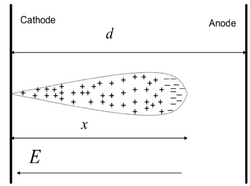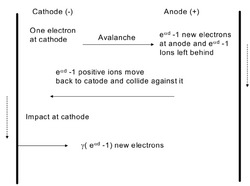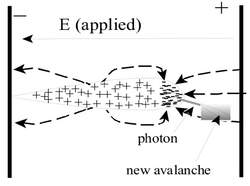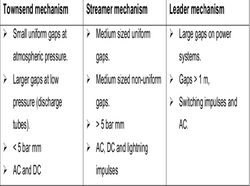Insulators under a high voltage
Introduction
Air is one of insulators that prevent charge exchange between two charged conductors. Parallel plates is an example where the air is insulating the negatively charged plate from the positively charged one. Nevertheless, air does keep this properties when the voltage difference between the plates causes air ionization. the process will produce free electrons accelerates toward the positive plate.Enough number of these electrons will make the air a conductor and sparking is observed on the plates.
Processes leads to flashover
Flashover happens when the following processes take place:
- Avalanche formation
Physically is formulated using Townsend's primary ionization coefficient () that is defined as "The number of ionizing collisions that takes place during a unit length movement of one electron" <ref name="Dr JP Holtzhausen"> Dr JP Holtzhausen, Dr WL VoslooHigh "Voltage Engineering Practice and Theory" </ref>. A relationship is built combining the number of moving electrons (n) over a distance (dx) produce new free electrons (dn) as :
Solving the equation will give the number of the free electrons produced in a distance (x) as :
- Townsend discharges
Simultaneously happens with the first process, the gas ions will bombard the cathode, it will give energy to release new electrons. Townsend's secondary coefficient () is defined as "The number of electrons released at the cathode by the impact of one ion.
The impact will produce new electrons.
Based on the previous processes flashover appears, aslo can be represented by the following:
so
Falshover :
so :
where k is constant depends on the material's Townsend's coefficients, its value ranges from 2.5 and 18.
- Raether limit
limits the number of the free electron in an avalanche to 5 X 10^8, so
where x_c is the critical avalanche length.
The empirical result was based on a study included a growing avalanche by Wilson cloud chamber during the breakdown of gaps of different length and gas pressure. "When the length of the avalanche becomes large, the negative and positive charges in the avalanche distort the field in such an extend that new avalanches form ahead of the original avalanche, eventually bridging the gap." <ref name="Dr JP Holtzhausen"/>.
Sparking
Because of the increase in the voltage to a point to breakdown the gap, Sparking appears clearly in the area. The following table shows the mechanisms that possible to take place:
Other factors may also inrease the probability of the gas failure under a high voltage statement <ref name="Mazen A.salam">A.salam,A.,M.,R. (2000), "High-Voltage Engineering Theory and Practice", Marcel Dekker Inc.,2nd edition </ref> :
- a) Effect of Electrode
This effect appears clearly as the gas is under 200kV/cm, specially steel and copper electrodes.
- b)Conductor conditioning and surface roughness
Conditioning of the electrodes is defined <ref name="Mazen A.salam"/> "repeated breakdown affecting the electrode surfaces have their influence on the strength of the gap. the dielectric strength increases with the number of breakdowns until it levels off at an ultimate value.
The previous phenomenon discussed under using the gases as insulators, but in my opinion it may extend to the solid insulator as we happened many times as we are frequently using the coated THGEM foil.
- c) Problems Associated with solids spacers
1- Imperfect solid adhesion: Narrow gas created because of the imperfect casting for the spacers, or mechanical stress on the solid/gas interface.
2- Moisture content High humidity increases the dielectric constant. 50 percent drop in its value as the humidity increased from zero to 4000 ppm.(ref question?)
- d) Contaminant particles
Mainly Contaminants cause local field enhancement, and their oscillation between the electrodes under a DC voltage causes firefly. There are studies measured the effect of the contaminant geometry and have these particles free or not free on the breakdown voltage.
- e) Conductive coating
Coating helps in decreasing the roughness of the surface, also its high resistance has an advantage to decrease the development of the of pre-discharges in the gas which will help to increase the breakdown voltage.
- In Our Case
The test of the HT-THGEM foil in air and under the Ar/CO2 produces sparks, mechanism causes sparks will be dependent on the gap size. Based on the gas pressure, In air Streamer mechanism prevails, but in Ar/CO2 the mechanism causes sparking is going to be even Townsend's mechanisms or Streamer mechanisms depending on gas pressure surrounding the HTTHGEM foils, assuming all the reasons from a-d are maintained.
References
<references/>
- Dr JP Holtzhausen, Dr WL VoslooHigh "Voltage Engineering Practice and Theory" ISBN: 978 - 0 - 620 - 3767 - 7 (online drift copy)



